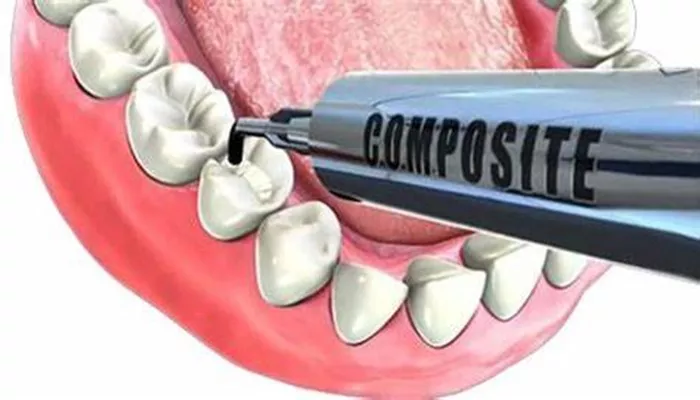Resin composite is a popular material used in dentistry to repair and restore teeth. It is a tooth-colored material made of a combination of plastic and fine glass particles. Dentists use resin composite for fillings, bonding, and cosmetic improvements. This material is strong, durable, and blends naturally with teeth, making it a preferred choice for both patients and professionals.
Composition of Resin Composite
Resin composite consists of several key components that make it effective for dental restorations:
Resin Matrix – This is the plastic (polymer) component that holds the material together. It allows the composite to be shaped and hardened.
Filler Particles – These are fine glass or ceramic particles that add strength and durability.
Coupling Agent – This helps the resin and fillers bond together, improving the material’s overall performance.
Photoinitiators – These allow the material to harden when exposed to a special light (curing light).
Uses of Resin Composite in Dentistry
Resin composite is a versatile material used for many dental procedures, including:
1. Dental Fillings
Resin composite is commonly used to fill cavities caused by tooth decay. Unlike silver amalgam fillings, composite fillings match the natural color of teeth, making them a more aesthetic option.
2. Dental Bonding
Composite resin is used in bonding procedures to repair chipped, cracked, or discolored teeth. The material is applied directly to the tooth and shaped to restore its appearance.
3. Veneers and Cosmetic Enhancements
Composite veneers are thin layers of resin composite placed on the front surface of teeth to improve their shape, size, and color. This is a more affordable alternative to porcelain veneers.
4. Sealants and Preventive Care
Some dentists use a flowable resin composite to coat the deep grooves of molars. This protects the teeth from decay, similar to traditional dental sealants.
5. Crown and Bridge Repair
Resin composite is sometimes used to repair small damages in dental crowns or bridges. It provides a quick and effective solution for minor repairs.
Advantages of Resin Composite
Resin composite offers many benefits, making it a preferred choice for dental restorations:
1. Natural Appearance
The material is available in different shades to match the color of natural teeth, providing a seamless look.
2. Strong and Durable
With proper care, composite fillings and restorations can last for many years. Advances in composite technology have improved its strength and resistance to wear.
3. Less Tooth Removal
Compared to silver amalgam fillings, resin composite requires less removal of healthy tooth structure. This helps preserve more of the natural tooth.
4. Bonding Strength
Composite resin bonds directly to the tooth, which helps strengthen the remaining structure and reduce the risk of fractures.
5. Mercury-Free and Safe
Unlike amalgam fillings, resin composite does not contain mercury, making it a safer option for patients concerned about metal exposure.
Disadvantages of Resin Composite
Despite its many advantages, resin composite also has some drawbacks:
1. May Wear Faster
Although strong, resin composite is not as durable as metal fillings and may wear down over time, especially in patients who grind their teeth.
2. Can Stain Over Time
Composite fillings can stain from coffee, tea, red wine, and smoking. Proper oral hygiene and regular dental cleanings can help prevent discoloration.
3. Requires More Time to Place
The placement of composite fillings takes longer than amalgam because the material must be applied in layers and hardened with a curing light.
4. Cost
Composite fillings are generally more expensive than amalgam fillings, but many patients prefer them due to their aesthetic benefits.
The Process of Applying Resin Composite
The procedure for placing resin composite restorations follows these steps:
1. Tooth Preparation
The dentist removes the decayed or damaged part of the tooth and cleans the area.
2. Bonding Application
A bonding agent is applied to the tooth to help the composite adhere securely.
3. Layering of Composite
The resin composite is applied in small layers, and each layer is hardened with a special curing light.
4. Shaping and Polishing
Once all layers are in place, the dentist shapes and polishes the filling to match the natural tooth structure.
How to Care for Resin Composite Restorations
To maintain the longevity of resin composite fillings and restorations, follow these simple care tips:
Brush Twice a Day – Use a fluoride toothpaste and a soft-bristled toothbrush.
Floss Daily – Flossing helps prevent plaque buildup around fillings and restorations.
Limit Staining Foods and Drinks – Reduce the intake of coffee, tea, and dark-colored beverages.
Avoid Biting Hard Objects – Do not bite on ice, pens, or hard candies, as this may damage the restoration.
Visit the Dentist Regularly – Routine check-ups and cleanings help ensure the restoration stays in good condition.
Conclusion
Resin composite is an essential material in modern dentistry. It provides a natural-looking, durable, and safe solution for restoring teeth. While it has some limitations, its benefits make it a preferred choice for both patients and dentists. With proper care, resin composite restorations can last for many years, helping individuals maintain a healthy and beautiful smile.

